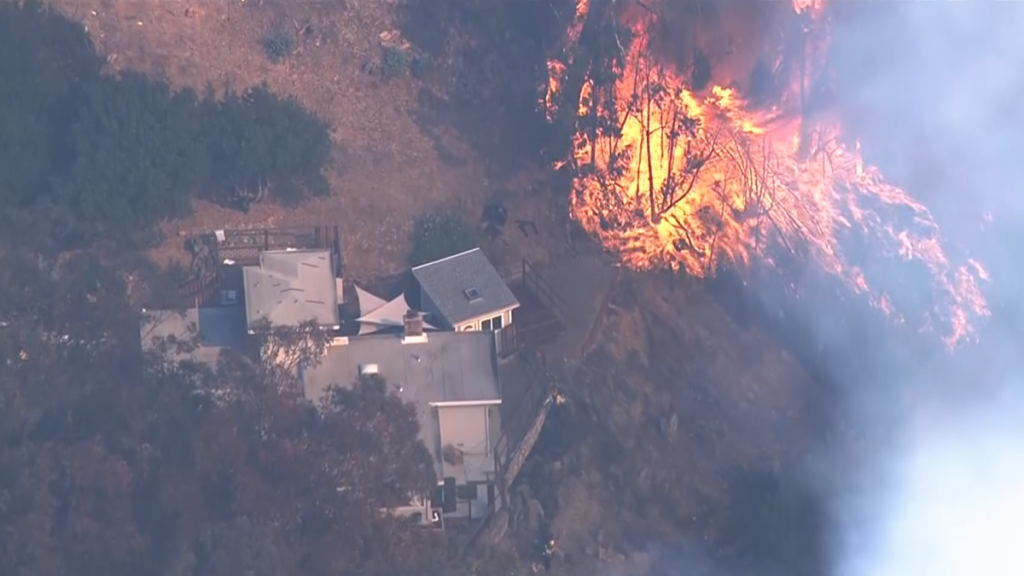On Friday afternoon, a rapidly spreading vegetation fire ignited in the hills of Oakland, California, prompting an urgent response from the Oakland Fire Department and resulting in the destruction of at least two homes. The blaze took hold near key locations such as Interstate Highway 580, Mountain Boulevard, and Keller Avenue. Initial reports indicated that multiple structures were compromised in the vicinity of Mountain Boulevard and Maynard Avenue, where flames engulfed at least four properties. The fire was first reported around 1:30 p.m., escalating quickly in severity. By 1:50 p.m., it had reached a three-alarm status, leading to the issuance of a fourth alarm by approximately 2:15 p.m. during a period characterized by winds measured at 11 mph with gusts reaching 22 mph, providing a challenging backdrop for firefighting efforts.
In a significant mobilization effort, over 80 firefighters, complemented by support from Cal Fire air units, were deployed to combat the fire. The incident intensified, eventually escalating to a fifth alarm. Firefighters struggled to contain the blaze for hours, and by 4 p.m., they had managed to halt its forward progression after approximately 13 acres had burned. Despite the damage to at least two structures, firefighters remained committed as they monitored the surrounding area, where dozens of additional homes were under threat but miraculously escaped significant harm. By 6 p.m., the Fire Department confirmed the loss of two residences while noting that the majority of properties in the area were spared.
In light of the unfolding situation, residents of the Caballo Hills neighborhood north of Highway 580 were evacuated, highlighting the urgency of the situation. The Fire Department specified evacuation areas that encompassed Campus Drive east of Stoneridge Court and all homes on Crystal Ridge Court. Furthermore, evacuation orders were extended to residents on Altura Place and Rifle Lane. An evacuation center was set up at Burckhalter Elementary School, serving as a refuge for those impacted by the fire. Frequent updates, including real-time evacuation maps, were made available as local authorities aimed to ensure residents had the latest information regarding safe areas and specific evacuation routes.
As firefighting crews battled the flames, the California Highway Patrol responded by implementing a severe traffic alert concerning the fire’s proximity to Highway 580. This led to the closure of all westbound lanes on the highway, creating complications for commuters in the area. Firefighters were observed extinguishing spot fires that had started along the highway shoulder, likely ignited by embers from the main fire front. By approximately 3:30 p.m., some westbound lanes were reopened, with full access restored by 4 p.m. The rapid escalation of the fire and its effects on local traffic underlined the urgency of the situation and the need for efficient management by local authorities.
With adverse weather conditions contributing to the fire’s rapid spread, the Bay Area was under a Wind Advisory, anticipating gusts of up to 50-65 mph in higher elevations. The National Weather Service had issued a Red Flag Warning across most of the Bay Area and Central Coast due to critically dry environmental conditions that rendered the landscape particularly susceptible to fires. The combination of strong winds and dry vegetation greatly exacerbated the fire risk, raising alarms within fire management agencies that were already contending with the fast-moving blaze. No immediate information regarding the fire’s cause was available, raising concerns as investigations began to identify potential origins.
This latest fire incident occurred at a time marked by historical significance, as it resembles a catastrophic firestorm that occurred nearly 33 years prior, on October 19, 1991. That devastating blaze, ignited by a smoldering grass fire that reignited, raged through the Oakland and Berkeley hills for days, resulting in the deaths of 25 people, hundreds of injuries, and the destruction of over 3,000 homes. The memories of such tragedies remain etched in the community’s consciousness, and the recent fire serves as a stark reminder of the persistent wildfire risks that threaten the region. As emergency services worked diligently to mitigate damage and protect lives, the Oakland community remained on high alert, bracing for the ongoing challenges posed by wildfire season and the associated hazards inherent in their environment.

